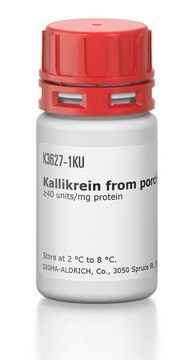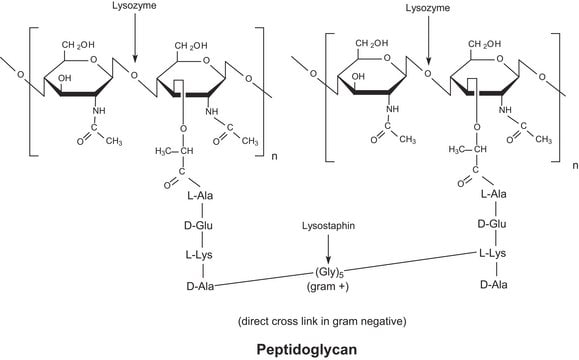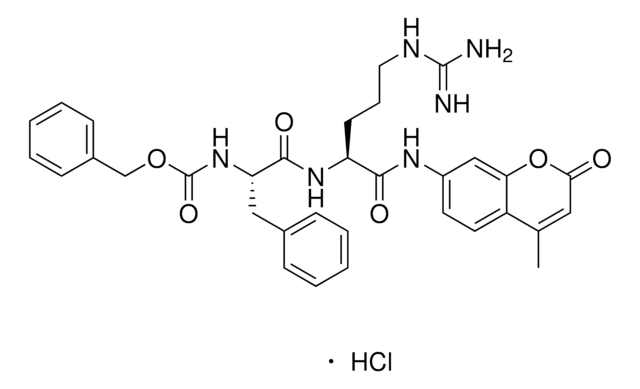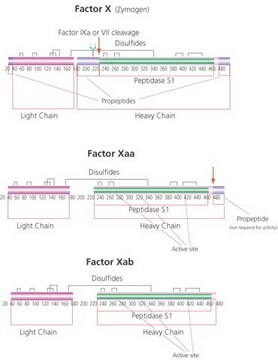K2638
Kallikrein from human plasma
buffered aqueous solution, ≥5 units/mg protein
Synonyme(s) :
Kininogenase, Kininogenin
Se connecterpour consulter vos tarifs contractuels et ceux de votre entreprise/organisme
About This Item
Numéro CAS:
Numéro MDL:
Code UNSPSC :
12352204
Nomenclature NACRES :
NA.54
Produits recommandés
Forme
buffered aqueous solution
Niveau de qualité
Activité spécifique
≥5 units/mg protein
Numéro d'accès UniProt
Conditions d'expédition
dry ice
Température de stockage
−20°C
Informations sur le gène
human ... KLK1(3816)
Vous recherchez des produits similaires ? Visite Guide de comparaison des produits
Description générale
Kallikrein-related peptidases belong to the family of 15 highly conserved trypsin- or chymotrypsin-like serine proteases. Plasma kallikrein (PK) is a serine protease derived from plasma prekallikrein, a zymogen found at higher levels in blood circulation. The KLKB1 gene is located on the human chromosome at 4q35.2.
Application
Kallikrein from human plasma has been used:
- to culture human hepatocellular carcinoma cell line
- to study its effects on the cleavage of Neisserial heparin binding antigen (NHBA) from Neisseria meningitidis
- in peptidase inhibition assay
Actions biochimiques/physiologiques
Plasma kallikrein (PK) is involved in the synthesis of bradykinin, maintaining the blood metabolite levels and hypertension. It also participates in the activation of coagulation factor XII, which promotes inflammation and the intrinsic coagulation pathway. PK controls proteolytic cascades in the cardiovascular system like the kallikrein-kinin system, renin-angiotensin system, fibrinolytic system, and the alternative complement pathway. It is involved in the cleavage of glucagon-like peptide-1 (GLP-1) and neuropeptide Y (NPY) which suggests that plasma kallikrein may affect metabolism and diabetes.
Définition de l'unité
One unit will hydrolyze 1.0 μmole of Nα-benzoyl-L-arginine ethyl ester (BAEE) to Nα-benzoyl-L-arginine and ethanol per min at pH 8.7 at 25°C.
Forme physique
Solution in 20 mM Tris-HCl, pH 7.8 with 100 mM NaCl.
Code de la classe de stockage
12 - Non Combustible Liquids
Classe de danger pour l'eau (WGK)
WGK 1
Point d'éclair (°F)
Not applicable
Point d'éclair (°C)
Not applicable
Équipement de protection individuelle
Eyeshields, Gloves, multi-purpose combination respirator cartridge (US)
Faites votre choix parmi les versions les plus récentes :
Déjà en possession de ce produit ?
Retrouvez la documentation relative aux produits que vous avez récemment achetés dans la Bibliothèque de documents.
Les clients ont également consulté
Xueqing Xu et al.
Nucleic acids research, 37(22), 7381-7393 (2009-10-13)
A subtelomeric region, 4q35.2, is implicated in facioscapulohumeral muscular dystrophy (FSHD), a dominant disease thought to involve local pathogenic changes in chromatin. FSHD patients have too few copies of a tandem 3.3-kb repeat (D4Z4) at 4q35.2. No phenotype is associated
Elisa Pantano et al.
PloS one, 14(8), e0203234-e0203234 (2019-08-02)
Neisserial Heparin Binding Antigen (NHBA) is a surface-exposed lipoprotein of Neisseria meningitidis and a component of the Bexsero vaccine. NHBA is characterized by the presence of a highly conserved Arg-rich region involved in binding to heparin and heparan sulphate proteoglycans
H Austin et al.
Journal of thrombosis and haemostasis : JTH, 9(3), 489-495 (2011-01-15)
We evaluated 10 single-nucleotide polymorphisms (SNPs) identified in three European case-control studies as risk factors for venous thrombosis. We sought to replicate the positive findings from this report among Whites and to evaluate the association of these SNPs with venous
L E Stolz et al.
Drugs of today (Barcelona, Spain : 1998), 46(8), 547-555 (2010-09-11)
Hereditary angioedema (HAE) is a debilitating, potentially fatal disease characterized by variable and unpredictable acute attacks of swelling affecting the subcutaneous tissue and mucosa. It is an autosomal dominant disorder resulting from a genetic deficiency of functional C1-esterase inhibitor. Available
A new case of homozygous C1-inhibitor deficiency suggests a role for Arg378 in the control of kinin pathway activation.
Alberto López-Lera et al.
The Journal of allergy and clinical immunology, 126(6), 1307-1310 (2010-09-25)
Notre équipe de scientifiques dispose d'une expérience dans tous les secteurs de la recherche, notamment en sciences de la vie, science des matériaux, synthèse chimique, chromatographie, analyse et dans de nombreux autres domaines..
Contacter notre Service technique












